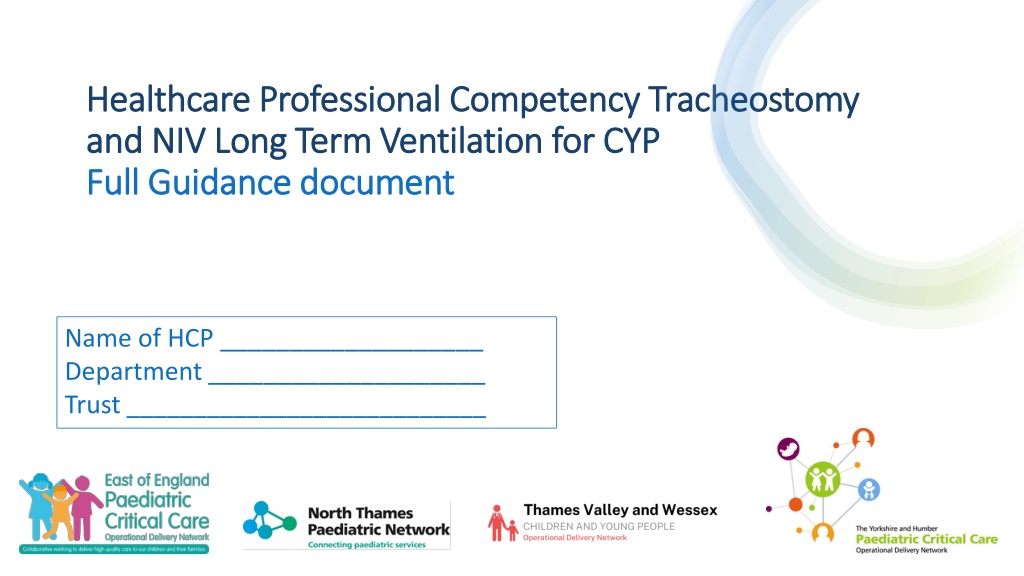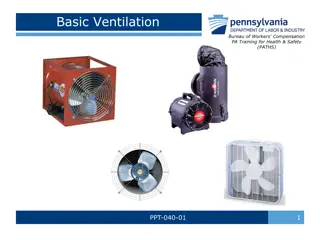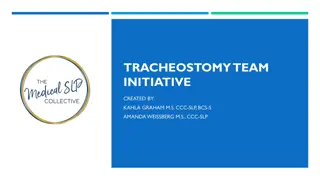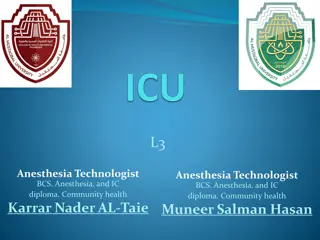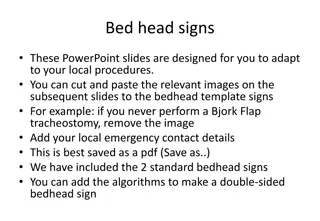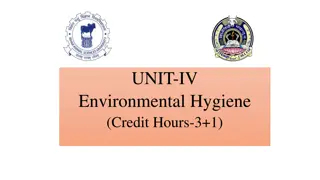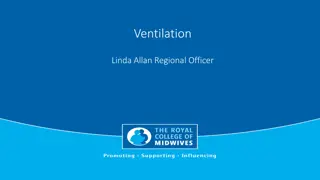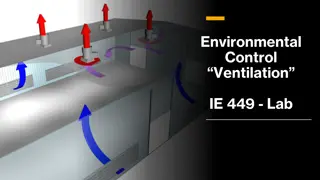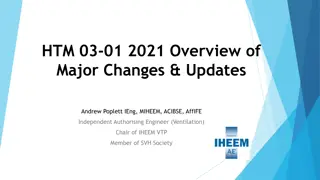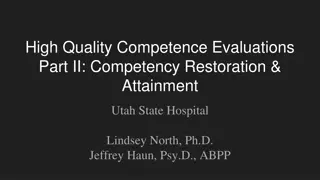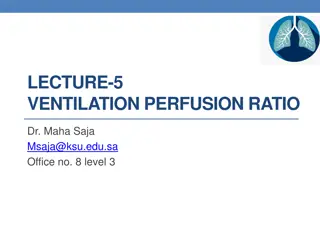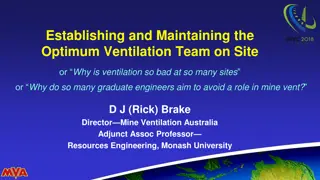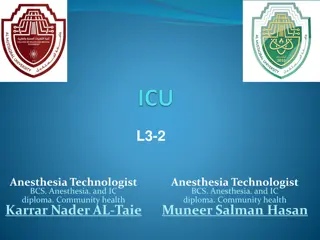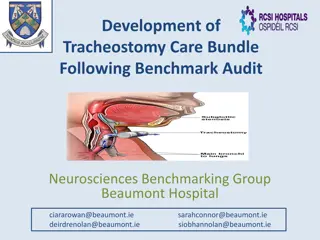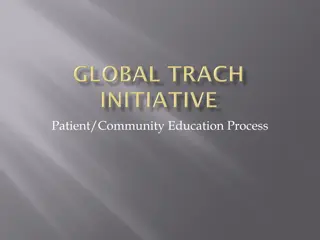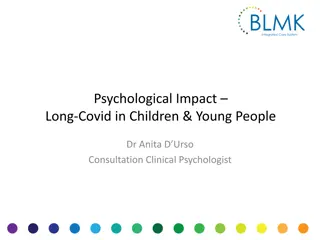Healthcare Professional Competency: Tracheostomy and Long-Term Ventilation for Children and Young People
This document provides guidance for healthcare professionals caring for children and young people requiring tracheostomy and long-term ventilation. Developed by experts in pediatric care, the competencies cover essential skills and knowledge necessary for safe and effective patient care outside tertiary settings. The document aims to assess and certify healthcare professionals' competence in managing tracheostomy and ventilation needs for pediatric patients, emphasizing the importance of adherence to local protocols and ongoing equipment training. Final sign-off is required by senior staff members with relevant clinical experience and supervision capabilities.
Download Presentation

Please find below an Image/Link to download the presentation.
The content on the website is provided AS IS for your information and personal use only. It may not be sold, licensed, or shared on other websites without obtaining consent from the author. Download presentation by click this link. If you encounter any issues during the download, it is possible that the publisher has removed the file from their server.
E N D
Presentation Transcript
Healthcare Professional Competency Tracheostomy Healthcare Professional Competency Tracheostomy and NIV and NIV Long Term Ventilation Long Term Ventilation for CYP Full Guidance document Full Guidance document for CYP Name of HCP ___________________ Department ____________________ Trust ___________________________ 1
Scope of this document Scope of this document This competency document (2022) was amended from a competency document developed by Tracheostomy and LTV specialists, and the Paediatric Pan London Long Term Ventilation Group (PPLLTV). The PPLLTV is a group of clinical nurse specialists and allied health professionals. The authors are experts in the care of paediatric tracheostomy, tracheostomy long-term ventilation and non-invasive ventilation and work within the Operational Delivery Networks of East of England, North and South Thames, Thames Valley and Wessex, and Yorkshire and Humber. These competencies are aimed at Healthcare Professionals (HCP) working outside of the main tertiary settings and looking after patients in their local healthcare environment. These competencies are freely available for use by all, but practitioners should always refer to their local guidance if planning to use them in their own services. This document has been devised to enable the assessment of a Healthcare Professionals (HCP) competence to care for a child and young person (CYP) requiring a tracheostomy and long- term ventilation as well as those requiring non-invasive ventilation on a long-term basis. It is to be used in combination with the relevant guidance notes for the ventilator the CYP is utilising. This document is a guide for the assessor to enable sign-off, of the associated competency document. It follows the same format as the competency document and has been divided into two sections to denote the theory and care required universally for all patients requiring Long Term Ventilation (LTV) and those that may be required for equipment use. The skills in which there are differences between tracheostomy ventilated patients and those using other ventilator interfaces have been highlighted through splitting the sign off box for that competency. The sections relevant to the CYP being cared for should be completed to an appropriate level. Competence is defined as having the ability to care for children on Long Term Ventilation, with or without a Tracheostomy in situ, safely. A HCP is deemed competent to safely care for a CYP on LTV following completion of the competence sign off at the end of the non-ventilator specific section. They should then undertake any relevant training for each piece of equipment that they may use. This can be done at a later date, as they use each relevant device. The ventilator specific section checklist at the end of this document can then be completed for each device they have received training in. The professional should demonstrate that they can undertake each relevant section and can consistently replicate each aspect of care in a variety of contexts. When that person feels confident and competent, they will sign each relevant section. Each section will be assessed and signed, by a qualified professional (assessor) once competency has been achieved. Final sign off needs to be completed by a senior staff member with clinical experience and competency in line with local policy as well as having experience in supervision and assessment. They should have either been aware of all the training done previously or as a minimum verbally go through the competency book and then complete final sign off. It is however, recognised that when introducing this competency document, there may be insufficient HCP's that have achieved these competencies to be supervisor and assessor of HCP s completing this process. Until such a time, a pragmatic approach should be applied. For Guidance on the management of a CYP on LTV see: LTV in Children and Young People Clinical Guideline 2
Training Tables Training Tables The next 3 pages of the competency document have been created to provide evidence of training received and document assessors that have signed the competency document. Below are examples of the pages you will find in the competency document. Training Schedule Training Schedule Date and Time Session Trainer name Initials of trainer This section requires you to input any training sessions completed related to Long term ventilation and tracheostomy care. This can include rep training on equipment, tracheostomy training, Long term ventilation study days, respiratory training etc. Signature record of supervisors/assessors Signature record of supervisors/assessors Name Designation Signature Initials Any HCP signing this document should input their details on this page. The member of staff signing each competency should have confidence the HCP can undertake each relevant section safely and can consistently replicate the aspect of care in a variety of contexts. Equipment for which you have received training Equipment for which you have received training Notation Equipment i.e., ventilator model, humidifier model Date Signature Please use this table to document any device training related to Long Term Ventilation and Tracheostomy care. You can use the bottom half of the table for re-certification of equipment. Copies of these pages can be made once they are full. 3
COMPETENCIES TO BE COMPLETED UNDERSTANDING CYP S NEED FOR VENTILATION (NON-VENTILATOR SPECIFIC) discuss issues such as airway resistance (obstructed upper airway, abnormal anatomy of upper airway, Obstructed Sleep Apnoea (OSA), lung compliance, increased airway resistance), weak respiratory muscles, cardiac impairment (abnormal anatomy of the thoracic cavity), spinal cord injury (SCI) and neurological impairment (poorly functioning chemo receptors and nervous system). Aware of the type of CYP's requiring LTV discuss the use of manuals, ventilator training alliance (VTA) app, LTV hub QR codes, teaching resources from the LTV ODN, tertiary centres, reps, study days available, local support. Aware of the different types of ventilators and how to access ventilator specific information: manuals, teaching resources, reps and LTV support understands the concept of Continuous positive airway pressure as a one flow and how Bi-level involves an Inspiratory Positive Airway Pressure and Expiratory Positive Airway Pressure, can discuss the reason they may be used and how dependency on the ventilator is different Able to describe the differences between CPAP and Bi-Level ventilation and the implication of this to the CYP can explain what pressure support and pressure control is, discuss the settings involved such as IPAP, EPAP, trigger, back up rate, inspiratory time. Able to describe in basic terms the different type of Bi-level ventilator modes i.e. ST can discuss the management of the well and unwell CYP receiving LTV, complications and different management. The potential increased dependency of a CYP with a tracheostomy, advantages of having a permanent airway and the complication this can bring e.g. obstruction, displacement etc. Can recognise how the unwell NIV CYP may have increased respiratory/ventilation needs when unwell and how this may not be met via the NIV route and what escalation would involve. Aware of the importance of understanding why each individual CYP needs ventilation and what their individual dependency on this is e.g. CYP may tolerate all day off ventilator when well, however when unwell or asleep they may be fully ventilator dependent. To be aware of respiratory action plan. Can discuss the different levels of dependency of CYP on LTV and the differences between NIV and Tracheostomy ventilation can explain what RAMP is, how the ventilator initiates a lower pressure and then gradually increases to the pressures prescribed in the settings specific for that CYP. Able to discuss that its used for compliance, for non-dependent CYP, may not be appropriate when unwell and setting may need de- activating. Can discuss what RAMP is in basic terms and why this would be set for a CYP 4
COMPETENCIES TO BE COMPLETED UNDERSTANDING CYP S NEED FOR VENTILATION (NON-VENTILATOR SPECIFIC) Can explain what a respiratory action plan is and how this would be used to guide treatment. If a CYP does not have one available, they should be able to discuss how to access either by contacting the tertiary centre LTV team, community nurses, GP/Consultants discharge letters, parents, out of hours respiratory/ICU team at the tertiary centre. Understands what a respiratory action plan/escalation plan is and what to do if your CYP does not have one available to access understands why some CYP's may or may not have more than one setting, wet/dry circuits, well/sick , day/night settings. Discuss why a CYP would have more than one programme set ensure CYP is safe, escalate to nurse in charge, local medical team, contact tertiary centre, check respiratory action plan, check documentation to see if the changes made were planned but also ask medical team in case documentation has been forgotten. Consider changes made by parent/carers and potential safeguarding concerns. Discuss caution to be taken, putting settings back to original such as sudden pressure changes, reduction in support and how this can impact the CYP. A slow wean may be needed if the changes are significant, discuss with medical team and tertiary centre if appropriate. Follow local incident reporting policy. Can discuss what should be done if the settings are different from the prescribed ventilation plan aware of local paperwork if applicable, LTV guideline to be used for reference. Is aware of the daily safety checks that need to be completed for a CYP on NIV/Tracheostomy ventilation Humidification discusses the different types of HME when on and off the ventilator, weight restrictions, oxygen delivery, wet and dry circuit, administering a nebulisers. Aware of the need for a HME to be added to the tracheostomy and when this may not be required discusses the use of humidification through the ventilator routinely, when unwell and changes in humidification needs, environmental factors. Can explain why and when humidification is required has knowledge of different ventilators/humidifiers, integrated and external, different tubing, HME for tracheostomy Can identify different humidification devices for tracheostomy and Non-Invasive Ventilation 5
COMPETENCIES TO BE COMPLETED UNDERSTANDING CYP S NEED FOR VENTILATION (NON-VENTILATOR SPECIFIC) Humidification discusses the use of nebulisation to aid the clearance of thick secretions alongside the use of humidification. Understands the implications of a change in length of time on humidification, increasing temperature/level of humidification, the possibility of moving from the integrated humidification system to external if need is higher and how this can be achieved. Discuss how humidification can be used if the CYP is suffering from thick tracheostomy secretions, severe oral dryness and mask congestion, specifically how a change in environment may alter humidification needs: ensure an external humidifier is positioned below the ventilator and CYP, ensure the integrated humidifier is at CYP level or below. Understands the risk of water (rain out) mixing with electrical device and the risk to CYP's lungs from aspiration. Understands the importance of humidifier positioning: Aware of the reasons for NOT transporting a CYP on a wet circuit and the importance of this risk when electricity and water mix, water going into CYP'S lungs and aspiration risk when moving. aware of temperature/humidity requirement of a tracheostomy, not as effective, infection risk. Understands why an integrated humidifier cannot be used on a tracheostomy. Oxygen understands the importance of knowing CYP normal Oxygen requirement and Saturation levels and respiratory action plan. Discusses the important of setting appropriate alarm limits on the saturation monitor according to CYP's normal parameter and the need for added monitoring/escalation if they are not achieving these. Discusses how to escalate appropriately and how to deliver Oxygen and follow an A-E assessment. Can discuss the use of Oxygen according to CYP's Respiratory Action Plan (RAP) for routine and escalation management: discuss how Oxygen can be delivered via the ventilator, either administering through the circuit or entrained to the device from the back and the need to turn Oxygen off when not in use. Aware that different devices use different techniques and how to find ventilator specific information: manuals, VTA app, LTV hub QR codes, use of ventilator reps. Can discuss Oxygen use in relation the CYP both on and off the ventilator and escalate to LTV centre as per respiratory action plan. Aware of the methods of Oxygen administration for a CYP on LTV, how this may differ between different ventilators and where this information can be found: 6
COMPETENCIES TO BE COMPLETED UNDERSTANDING CYP S NEED FOR VENTILATION (NON-VENTILATOR SPECIFIC) Nebulisation discusses what nebuliser treatment can be used and how this can be delivered, wet and dry circuit, CYP normal and escalation protocol, some CYP's may have antibiotic nebulisation routinely or in escalation plan. Consider CYP's ventilation needs and how the nebuliser should be delivered for differing dependency and the use of an aeroneb/jet nebuliser system. Understands the different uses for nebulisation and how this should be delivered to the CYP on LTV and the different methods used for a wet and dry circuit: discusses the washing of equipment, how often consumable should be changed following local and manufacturers guidance. Where manufacturers guidance can be found: ventilator manuals. Aware of how to remove the nebuliser, clean equipment and how frequently to change consumables: check local policy, BNFC and local pharmacist. A filter may need to be added onto some of the nebulisers you are delivering. Consider other safety precautions that may be advocated by your local policy e.g. minimising people in the room, opening a window. Discuss why this is important, safety of CYP and staff. Is aware of the appropriate precautions for the delivery of antibiotics and aware of how to set up antibiotic nebulisation according to local policy: Ventilation operation Air inlet filters explain where the air is taken into the ventilator and how the blocking or partial blocking can result in insufficient delivery of pressures, overheating, increased battery use, machine malfunction, fire. Able to explain the purpose of the air inlet and aware of the importance of keeping this clear: Aware how frequently the air inlet filter should be changed and that more frequent changes may be required. Can discuss the reasons for this: discussesthe different manufacturers guidance and where the information is located, how to check filters and the importance of this, increased changes may be needed for dusty properties, houses with animals, ventilator kept close to a carpeted floor, high ventilator requirements. Ventilator Power Supply Able to connect the ventilator to the main power supply: discuss the importance of keeping the ventilator plugged in to the mains when not transporting and implication to the CYP if the power ran out: unable to ventilate, use of external battery and the charging of batteries. 7
COMPETENCIES TO BE COMPLETED UNDERSTANDING CYP S NEED FOR VENTILATION (NON-VENTILATOR SPECIFIC) Ventilator power supply Able to explain what to do in a power outage or evacuation: Discuss the importance of daily checks, the need for planning, ensuring batteries are on charge, ventilator is connected to the mains and ventilator is charging, ensure the second ventilator (if appropriate) is fully charged when not in use, what are the considerations when moving a CYP, importance of emergency equipment, if site has a generator back up ensure ventilator is plugged into appropriate power source for this. Able to identify when batteries need charging, how to do this, the need to ensure the battery supply is sufficient for that ventilator/CYP dependency and factors that affect battery life: discuss how to check the battery charge of the ventilator, to ensure the batteries are charging/fully charged and the importance of this in their daily checks, understands what drains the battery and how this affects your running time off the mains. Be aware of the different batteries available for different ventilators and if there is an internal/external battery, the implications of this and where this information can be found: Understands factors affecting the battery life eg, increased pressures, age of battery. check with parents, manual, contact reps or tertiary centre if there is a planned journey where battery life is not long enough. Discuss options to plug in machine intermittently as available. The importance of planning. Aware of where to find the ventilators estimated battery length (if applicable) Circuits Can discuss the different types of circuits that can be used in LTV e.g. single, double limb, wet and dry circuits: aware of the CYP's specified set up. That there are different tubing for different patients weight/age, circuits for integrated and external humidifier, connections. Is able to discuss a single limb circuit and how the flow of air travels. There needs to be an awareness that there are double limb circuits but unlikely to see these outside a high dependency unit. Understands and can discuss the different parts of the circuit: Can explain the difference uses of integrated humidifier (NIV) and external wet circuit, humidifier chamber, dry circuit, bacterial filter if appropriate, temperature probes, exhalation/leak port and why this is important in a single limb circuit 8
COMPETENCIES TO BE COMPLETED UNDERSTANDING CYP S NEED FOR VENTILATION (NON-VENTILATOR SPECIFIC) Circuits aware that there is an intentional leak and locate where the leak can be found on different circuits and interfaces, importance of a vented mask (NIV), how to check patency using a visual inspection and hovering hand over to check air is flowing through, the importance of this as part of your airway assessment in your A-E assessment. Can discuss the relevance of an intentional exhalation/leak port on a single limb circuit, where it is located and how to check patency. discuss how this can affect exhalation of CO2. Hypercarbia, if untreated may result in death. Aware of how to unblock the port such as readjusting interface, cleaning. Recognises and can discuss the risks if the exhalation/leak port is blocked: Is aware how the 15mm and 22mm sized circuit related to the internal diameter of the tubing, to not rely on the colour or style as this can vary with manufacturers, the importance of ensuring you have the correct circuit, and be aware a learn circuit/calibration may need to happen if there is an intentional change of circuit size or type on some ventilators. Circuit type should only be changed in discussion with the patients' tertiary centre. Aware of the different sizes of circuit available, why a patient may be on the particular sized circuit and risks if they do not have the correct circuit in place: discusses how to check this information, manufacturers guidance, local infection control policy (filters), use own judgment if consumable are visibly dirty Aware of the consumables (interface (NIV)/circuit/filters) and when they need changing: common problems, water in tubing, unintentional leak, different tubing, ensuring the right circuit is on the right profile, where to find this information: information given by the machine, manuals, VTA app, LTV Hub QR codes Able to troubleshoot common problems regarding circuit e.g. failed learn circuit, leak, rain out, temperature variations, environmental influences: Ventilation operation - Alarms discusses a normal A-E assessment and discuss specific aspects to NIV and tracheostomy, Displacement, Obstruction, Pneumothorax, Equipment, Stomach (DOPES), delivery issues regarding leak, positioning, poor fitting interface. Two main causes of urgent alarms are either a blockage or a leak. DISCUSS THE IMPORTANCE OF AN A-E ASSESSMENT WHEN RESPONDING TO YOUR ALARMS!: able to identify that there is something wrong with the CYP's ventilation and complete an A-E assessment. If the alarms are not set appropriately the machine will not sound when ventilation is affected and the CYP can be at risk of harm. The alarm settings should not be changed unless guided by Discuss the importance of having appropriate alarms and implications to ventilation when set incorrectly: 9
COMPETENCIES TO BE COMPLETED UNDERSTANDING CYP S NEED FOR VENTILATION CONTINUED (NON-VENTILATOR SPECIFIC) Ventilation operation - Alarms Able to demonstrate how to check the alarms are working and how often to do this : whilst ventilator is running but not connected to the CYPcover end of circuit with a gloved hand ensuring an appropriate alarm for obstruction sounds, disconnect tubing ensuring an appropriate alarm for disconnection sounds. Cannot be done if the ventilator is on the CYP unless they tolerate disconnection or hand ventilated breaths are delivered. discuss the importance of checking CYP before the ventilator, A-E assessment of CYP, DOPES then work way back to ventilator, where to find out alarms and what they mean in the manual, VTA app, LTV hub QR codes. Able to explain what the different priority alarms means such as red as a high priority. Aware of how to troubleshoot alarms using an A-E assessment of your CYP able to discuss the difference in the priority alarms. Red Flashing bar High priority and requires immediate response. Yellow Flashing bar Medium priority requires prompt response. Yellow Steady bar is a low priority alarm and is an information alarm. All alarms should be responded to immediately and a full A-E assessment of the CYP should take place before attending to the ventilator. Direct supervision is required if alarms ate silences/suspended. Alarms should NEVER be ignored. Can describe the level of importance of alarms e.g. information alarm and warning alarms : ensure CYP is safe, refer to ventilation manuals, LTV hub QR codes, Ventilator Training Alliance app, escalate to LTV centre, ventilator servicing company. Aware of the processes to follow if you cannot find the cause of the alarm and who to contact: A-E assessment, observe the CYP, listening for noise and feeling for leak around the edges of the mask, re- adjust the mask using a 2 person technique where possible to reposition and tighten or loosen straps as appropriate, discuss what to do if the mask appears the wrong size, contact tertiary centre for advice. Can demonstrate and discuss how to solve unintentional leaks on a NIV interface aware the alarm may continue throughout the administration of a jet nebuliser but the importance to remain with the CYP throughout, if the alarm is triggering when using the aerogen, there is a problem as no alarm should be triggered. Aware of the effect of some nebulisers in circuits and how this can trigger alarms: 10
COMPETENCIES TO BE COMPLETED UNDERSTANDING CYP S NEED FOR VENTILATION CONTINUED (NON-VENTILATOR SPECIFIC) NIV interface is able to show or discuss how to fit the different interfaces and how to ensure it fits well and where this information can be found, LTV hub QR codes. To refer to tertiary centre if the mask is thought to be the wrong size. Troubleshooting such as mouth breathers, use of dummy, chin straps (if given by the tertiary centre). Able to fit the interface correctly and check the tightness of the straps. Can discuss the implications of a poorly fitted interface. describe a vented and non-vented mask, checking exhalation/leak port by holding hand over port whilst ventilation running. Aware of the different vented interfaces and the importance of the exhalation/leak port: A-E assessment, suction, positioning of CYP, removing interface and cleaning Aware of the risk of airway obstruction and action to take if this occurs : redness after 1 hour of removal of interface, escalate to tissue viability locally and to tertiary centre. If CYP has alternative interface consider alternating interfaces. Able to identify early signs of a pressure sore and how to escalate appropriately : discuss with tertiary centre regarding upsizing, or replacing interface. Routine changes should be manufacturer and tertiary centre driven or obtaining a replacement of the same mask already in use. Aware of how to obtain a new interface if required : checking manufacturers advice, tertiary centre, visual inspection of interface. Aware of how to clean and dry the interface and how often this should be carried out : Transferring of the patient local checklists available and the LTV guideline. Identify the equipment needed to transfer, and how to safely secure all equipment: ensure mains battery is plugged in prior to transfer, ensure portable batteries are fully charged, calculate oxygen requirement and ensure cylinders are full. Journey time X prescribed O2 requirement = Total amount needed for journey, double the amount for safety. For example, the CYP is on 2L/min O2 and it going out for 60 mins. Therefore, they need 60 x 2=120ltrs of oxygen. Double this so 120 x 2 = 240 ltrs to cover you in the event the trip is longer than expected Ensure you have enough Oxygen and battery supply for the journey required: BOC Medical Cylinder data chart: Cylinder code= capacity in litres. AZ 170litres CD 460 litres C 170 litres E 11 680 litres
COMPETENCIES TO BE COMPLETED UNDERSTANDING CYP S NEED FOR VENTILATION CONTINUED (NON-VENTILATOR SPECIFIC) Transferring of the patient discuss why a BMV is needed, how a BVM is still needed if an anaesthetic breathing circuit is being used due to the reliance of air/oxygen supply with the anaesthetic breathing circuit. Discuss BLS and tracheostomy specific BLS, discuss the importance of having knowledge of patent upper airway and the use of a laryngeal mask and when this is appropriate. Ensure you have an appropriate Bag-Valve- Mask with correct facemask (or laryngeal mask if appropriate) discuss the importance and demonstrate how these checks will take place, ensure obstruction and disconnection alarms have been checked, ensure CYP is on ventilator and ventilating using an A-E assessment. Refer to the LTV guideline and local policy. Aware of the equipment needed and able to check the function of the ventilator prior to transfer: storing safely, ensuring equipment is put back on charge, replace any equipment used. Can discuss the safe unpacking and recharging of equipment following a transfer : Emergency Management assess and treat A-E and ensure equipment is working, check airway patency, respiratory sounds, increase/decrease in respiratory effort, poor chest movement, increased PEWS, escalate to NIC and medical team,. Able to carry out an A-E assessment, describe signs of respiratory distress and actions to be taken : discuss local PEWS and SBAR policy Aware of hospitals escalation process for the unwell child using local resources such as PEWS: how Oxygen is attached to ventilator, maximum that can be administered, Oxygen delivery via Ambubag, facemask, Nasal spec, trachy mask, Optiflow, does the patient have a second device, other ventilator devices within the trust acutely if deteriorating on advice from tertiary centre and/or transport team. Can discuss the need to administer Oxygen in an emergency via the ventilator and other means if there is a ventilator delivery failure: retrieval team, tertiary centre contact details, how to find contact numbers, respiratory team at tertiary centre if unknown or out of hours. Aware of how to contact the tertiary centres and retrieval teams for advice and escalation: where this is found and how to access if not with parents tertiary centre respiratory or PICU team should have access out of hours, in hours LTV team at tertiary centre. Aware of CYP's escalation plan (if available) within the RAP. 12
COMPETENCIES TO BE COMPLETED UNDERSTANDING CYP S NEED FOR VENTILATION CONTINUED (NON-VENTILATOR SPECIFIC) Emergency Management discuss BLS for tracheostomy and non-tracheostomy CYP. Up to date with paediatric BLS. Discuss the teams that should be involved in the escalation, local escalation policy, the need to update and get advice from the LTV team at the tertiary centre and local retrieval team if appropriate. In the event of a respiratory arrest, aware of relevant BLS algorithms: able to discuss where this information can be found if unsure: manual, VTA app, LTV hub QR codes. Discuss the importance of re-locking the machine and the risk of not doing this. Aware of how to unlock the device, make changes and re-lock the device if required under consultation with the CYP s specialist centre and/or retrieval team: Non-ventilator specific sign off This section is to enable the assessor to sign off either or both competencies for tracheostomy LTV patients and LTV patients using other non- invasive interfaces. There is also a section to ensure that Tracheostomy competencies have been completed alongside that for LTV for those patients with a tracheostomy and requiring ventilation 13
COMPETENCIES TO BE COMPLETED VENTILATION OPERATION (VENTILATOR SPECIFIC) Ventilator operation locate plug to ensure ventilator is running on mains, locate on/off button and confirm if ventilation starts automatically, locate where indicator is for mains or battery use Able to turn the ventilator power on and off and determine if using mains or battery power : can discuss how to the locate battery life indicator on main screen. Some ventilators will estimate the battery length but ensure ventilator is plugged into the mains as long as possible and external batteries are fully charge before starting journey. Aware of how to find out length of battery life: Able to turn on the ventilator and start ventilation and carry out safety checks: confirm theneed to start ventilation and if so, how this is done. Staff need to be aware that different ventilators start as soon as the ventilator is turned on and others need to have the button ventilation start confirmed once in the stand by mode. Importance of assessing patient on initiation of ventilation. locate ventilator settings against the prescription using RAP, check all profiles if applicable. Escalate to LTV centre if there are any concerns including no available RAP. Able to check ventilator settings against the respiratory action plan: may be on the main screen or need to go into settings. Can demonstrate how to discontinue the Ramp setting (if set) when acutely unwell: discuss how to do this if only one program is set Is able to change between patients set programs: can locate the screen and discuss what the monitoring screen is showing, pressure, flow, VT, etc. Can identify where the monitoring screen can be found on the device to ensure the ventilation is delivering effectively when on the CYP and aware of the need to carry out an A-E assessment of the CYP: Can identify where the data can be downloaded from the ventilator e.g. USB port/SD card : can locate where the port card should go, not expected to know how to do this. You would not be doing without advice form the reps or tertiary centre. 14 can explain how this is displayed on the ventilator. Can identify if a breath is triggered by the CYP or the ventilator :
COMPETENCIES TO BE COMPLETED VENTILATION OPERATION (VENTILATOR SPECIFIC) Circuits demonstrate this in practice and discuss the different parts of the circuit and what they do. Is able to discuss and demonstrate the dry circuit set up on device: demonstrate this in practice and discuss the different parts of the circuit and what they do. Is able to discuss and demonstrate the wet circuit set up on device: demonstrate how this is done and discuss why and when it is needed e.g. different tubing, wet/dry circuit, adding in extra equipment such as Oxygen, and when troubleshooting alarms. Is able to discuss what a Circuit Calibration (Learn circuit) is and when this should be performed. (If applicable): Oxygen delivery demonstrate how this is done and discuss what flow the machine can use, some machines require the Oxygen to be off when the machine is turned on. Can demonstrate how to attach Oxygen to the ventilator: Can discuss and demonstrate how to measure Oxygen delivery via the ventilator when required: discuss how this can be done if not currently used on the machine/CYP. Nebulisation demonstrate using the device used locally or by the patient, you may require device training on the Aerogen if not used by your trust currently. (This can be added to the equipment training table). Is able to demonstrate how to attach a nebuliser set to the ventilator using the device available at your Trust (Aerogen, Jet nebuliser): Humidification demonstrate if CYP has humidity, if CYP does not have humidity discuss how this can be done on device if needed. Can discuss and demonstrate how to attach humidifier correctly to the ventilator and add water appropriately : 15
COMPETENCIES TO BE COMPLETED VENTILATION OPERATION (VENTILATOR SPECIFIC) Alarms show the alarm settings, discuss what the alarms represent. Aware of where to check what alarm settings are set and what they mean (if applicable): carry out an obstruction and disconnection alarm as you would for daily checks, if CYP is dependent and 2nd ventilator not available discuss how you would do this such as hand ventilating CYP with appropriate support. Able to demonstrate how to check the alarms are working and how often to do this : discuss where the alarm information can be found, manual, LTV hub QR code, Ventilator Training Alliance (VTA) app, information icon on ventilator as alarm is sounding, discuss importance of checking the CYP and carrying out an A-E assessment before checking the ventilator. Aware of how to troubleshoot alarms : demonstrate how to mute alarms and how to mute for longer periods if applicable, discuss if the ventilator unmutes when a new alarm is activated (some don t), discuss the risks to the patient if left muted: not recognising new alarms, current issue if not resolved; resulting in the CYP becoming unwell, ALWAYS check patient first, A-E assessment. Able to mute/unmute the alarm and aware of the risks if the alarm was left muted : Air inlet filters show and discuss what the filters do: some are bacterial, pollen etc. Is able to locate the air inlet filters on the ventilator: some filters are disposable, some need cleaning with warm soapy water, check manufactures guide for guidance how often to change but discuss the importance of visual checks and the need for more regular cleaning and what environmental factors can cause more regular changing. Able to change/ clean the air inlet filter and can discuss maintenance of the filters according to manufacturers and LTV centre guidance: Ventilator Specific Sign Off This section is to enable the assessor to sign of competence for each piece of equipment that there has been training delivered on and demonstration of competence has been shown. 16
